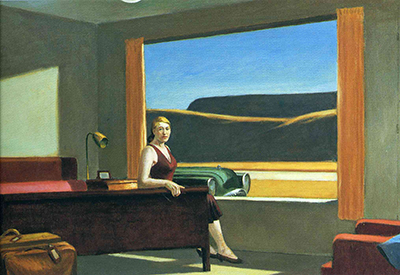Edward Hopper (1882 - 1967) was an American artist, predominantly remembered for his realist oil paintings and watercolours which drew from the commonplace in everyday American life.
Focusing on quiet and at times mundane aspects of such life, Hopper was a tremendous influence on modern American art, Americana and popular culture. Although his relationship with contemporary art critics and the art market of his time was a tumultuous one, he has since been commended in the public imagination.
Hopper remains influential to painters, filmmakers, photographers and writers, particularly in North America.
Hopper achieved his greatest breakthroughs in the 1920s after encountering the artist and his future wife, Josephine Nivison. Nivison famously encouraged his work and quiet lifestyle despite her own gregarious, sociable personality. Nivison became Hopper's prime estate manager and interlocutor, organising exhibitions at the Brooklyn Museum in 1923.
This began a new era of public success for Hopper. Hopper's continued success dampened the personal effects of the Great Depression, but that crisis still had an impact on the way in which Hopper painted and represented American life. Among Hopper's most iconic, stylistic and thematic tools was his use of quiet spaces and isolated figures, giving his paintings a muted and melancholic emotional resonance.
As such, Hopper's Western Motel is a painting of a solitary female figure, a frequent trope of his paintings. Framed as a fragment of a moment, his paintings marry tone, subject and surrounding to make juxtapositions between the lives of those depicted and our own. As with a photograph, we are left wondering what comes next.
Western Motel was painted in 1957. In this oil on canvas work, Hopper drew upon the most American of landmarks: a Motel. Its isolated figure—which is typical of Hopper's work— waits pensively in a motel bedroom with its windows open to the American landscape. The minimal furniture, large open space and sharp light works to symbolise the mobility of modernity and its effects on the human psyche.
Although Hopper was reluctant to define his work, the absence of identifiable personal belongings in the motel room points to the rootlessness of her situation. The car, parked outside, inevitably waits for her to move on. Far from exotic, the nondescript motel reduces American travel to the ordinary.




